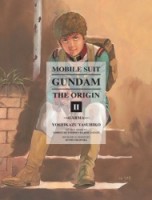 Creator: Yoshikazu Yasuhiko
Creator: Yoshikazu Yasuhiko
Original story: Yoshiyuki Tomino and Hajime Yatate
U.S. publisher: Vertical
ISBN: 9781935654889
Released: June 2013
Original release: 2006
Though I wouldn’t consider myself to be a fan of or even particularly knowledgeable about the massive Gundam franchise, at this point I would consider myself to be a fan of Yoshikazu Yasuhiko’s manga series Mobile Suit Gundam: The Origin. The manga is a retelling of the original 1979 Mobile Suit Gundam anime series from one of the artists who was heavily involved in its creation and visual design. Garma is the second volume in the collector’s edition of Yasuhiko’s The Origin manga, originally released in Japan in 2006. The English-language edition of the volume, published by Vertical in 2013, is a beautiful, high-quality release. This particular volume includes a small illustration gallery of Yasuhiko’s color work as well as a roundtable and special illustration from CLAMP. I was quite impressed with Activation, the first volume of The Origin, so I was looking forward to reading Garma a great deal.
After an eight-month armistice, the forces of the Earth Federation and the Principality of Zeon have once again come into conflict. The Federation’s colony Side 7 was attacked and destroyed when Zeon discovered the Federation military was secretly developing a highly advanced mobile suit there. White Base, the supply ship carrying the new weapon as well as hundreds of refugees from the colony, has reached Earth but Zeon’s pursuit has pushed it far off course. Trapped behind enemy lines and commanded by a young and inexperienced crew, White Base may have survived the initial confrontation with Zeon but the threat is far from over. The Zeon forces are determined to prevent White Base from breaking through to Jaburo; if they can’t capture the new technology, they are more than happy to destroy it. In particular, Colonel Garma Zabi, leader of the Zeon’s North American forces and the youngest son of its reigning family, is interested in the recognition, prestige, and military honor that successfully accomplishing such a feat would bring.
While in Activation the fighting primarily took place in space, the battles and skirmishes in Garma are surface based, occurring on Earth’s land, in its air, and even within a demolished urban center. Both Yasuhiko and the characters must make adjustments because of this. They must take into consideration and use the terrain and topography as part of their strategy. The battles in Garma literally, figuratively, and visually have weight. Even during the aerial maneuvers, Yasuhiko is constantly aware of the forces and gravity in play. The way he draws the battles makes them feel very different from those in Activation and they should be different—tactics and equipment change depending on the environment. Fighting on a planet is very different from fighting in space and he captures that remarkably well. The battles in Garma are engaging. Yasuhiko’s excellent pacing and layout combined with his color work result in some exceptionally stunning, cinematic sequences.
While the military aspect of The Origin is certainly important, perhaps even more important are the more personal human dramas of the story. As can be inferred by the volume’s title, Garma plays a particularly critical role at this point in the manga. Introduced at the very end of Activation, Yasuhiko quickly reveals Garma to be an arrogant and privileged young man. His relationship and association with Char, one of Zeon’s most formidable and calculating commanders, is crucial to the development of the story. Perhaps Garma’s complete opposite is Amuro Ray, the young pilot of the Federation’s new Gundam mobile suit. Drawn into war more by chance than by choice, at the age of fifteen he’s already seen more of battle than he ever wanted. He’s understandably terrified and struggling with the grave responsibility that has been thrust upon him. I’m very interested in seeing how the two sides of the conflict react to the events in Garma because they will have some major consequences.

I thought the time between the first week of the war and the attack on side 7 were a stalemate not an armistice or is that a change that was made for the manga ?
Ah, no, I think you may be right. It’s absolutely described as a stalemate, but there was also some talk about treaties, so I may have incorrectly assumed in my rush to use fancy English words. ^_^;